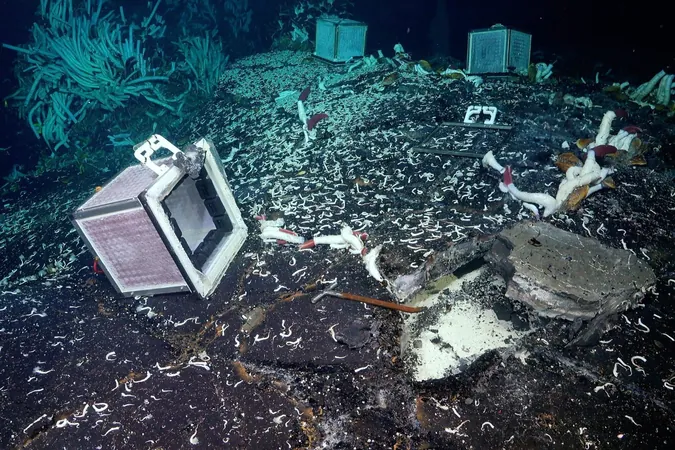
Groundbreaking Discovery: Life Thrives Beneath the Ocean Floor, Raising Hopes for Extraterrestrial Existence!
2024-10-15
Author: Jia
A remarkable team of scientists has unearthed astonishing evidence of macroscopic life thriving beneath the ocean floor, deep within one of Earth’s most extreme and enigmatic environments. This pivotal discovery not only complicates our existing understanding of living communities around hydrothermal vents but also provokes exciting questions about the potential for life beyond our planet.
While researchers were already aware of life existing in and around hydrothermal vents, the extent to which life forms might inhabit the sediments beneath miles of seawater was largely unknown. Recently published in Nature Communications, the researchers utilized a remotely operated vehicle named SuBastian aboard the research vessel Falkor (too) to dive approximately 8,250 feet (2,515 meters) into a section of the ocean floor they dubbed the Fava Flow Suburbs, located in the eastern Pacific Ocean.
Their findings are groundbreaking. 'Our discovery illustrates that animal life in the ocean extends beyond what is visible on the seafloor, penetrating into the shallow ocean's crust,' explained Sabine Gollner, a researcher at the Royal Netherlands Institute for Sea Research. The study illuminates the potential depth and horizontal extent of subseafloor habitats, which could play a vital role in the ecosystems surrounding hydrothermal vents.
Among the captivating marine life discovered were tubeworms, specifically Riftia pachyptila and Osedax alvinae, as well as mussels Bathymodiolus thermophilus, polychaete worms, and limpets. The researchers uncovered that these animals navigate through cavities located in the subseafloor, indicating a complex and interconnected ecosystem at play.
Using tools from SuBastian, the team drilled small holes into exposed pieces of igneous rock, lifted lava shelf sections, and sampled vent fluid to understand life beneath the ocean floor. They found that some cavities reached about 4 inches in height, housing macroscopic life. Remarkably, they identified tube worms measuring over 16 inches long, suggesting these habitats support adult life rather than merely acting as nurseries.
This extraordinary environment, with a consistent average temperature of around 64°F (18°C), facilitates survival for these unique creatures. As adults, tubeworms lose their traditional digestive systems, instead relying on bacteria Candidatus Endoriftia persephone for sustenance, which lives symbiotically within the worms.
What does this mean for astrobiology? The search for extraterrestrial life relies heavily on understanding the conditions Earth’s extreme environments can support. This recent research provides vital insights into what defines hospitable conditions, assisting scientists in their quests to identify potential life on distant exoplanets and the subsurface oceans of icy celestial bodies like Jupiter's moons.
'The exploration of the subseafloor biosphere is just beginning,' the team acknowledged in their publication. Their work is expected to deepen our understanding of hydrothermal vent ecology, biogeochemistry, and evolutionary connections, ultimately benefiting global biodiversity and conservation efforts.
In previous expeditions aboard the vessel Falkor (too), scientists uncovered new hydrothermal vents teeming with life, underscoring the pressing need for protective measures against activities like deep-sea mining that could threaten these rich ecosystems. Last year, the team also discovered an octopus nursery off Costa Rica’s coast.
The distinction of active hydrothermal vents is well recognized, and the findings about the subseafloor's biodiversity emphasize the urgent need for protective initiatives. Falkor’s earlier expeditions revealed invisible microbes, further illustrating the possibility of alien-like life forms existing right here on Earth.
This groundbreaking discovery opens up a galaxy of possibilities regarding the search for alien life. As we probe the unknown depths of our oceans, we are reminded that the universe might be brimming with unknown potential. Just like a recent study highlighted life teeming beneath Chile’s Atacama Desert, one of the most inhospitable environments on Earth, it becomes increasingly evident that life can thrive in places previously thought unimaginable.
While we still have much to discover about the great depths of our oceans and the harshest terrains on land, one thing is clear: life is resilient, and the quest for understanding its reach — not just on Earth, but potentially far beyond — is only just beginning.




 Brasil (PT)
Brasil (PT)
 Canada (EN)
Canada (EN)
 Chile (ES)
Chile (ES)
 España (ES)
España (ES)
 France (FR)
France (FR)
 Hong Kong (EN)
Hong Kong (EN)
 Italia (IT)
Italia (IT)
 日本 (JA)
日本 (JA)
 Magyarország (HU)
Magyarország (HU)
 Norge (NO)
Norge (NO)
 Polska (PL)
Polska (PL)
 Schweiz (DE)
Schweiz (DE)
 Singapore (EN)
Singapore (EN)
 Sverige (SV)
Sverige (SV)
 Suomi (FI)
Suomi (FI)
 Türkiye (TR)
Türkiye (TR)